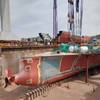Despite its remote location in the Northwestern Hawaiian Islands, Papahānaumokuākea Marine National Monument faces a looming threat of global climate change that will affect its land and marine ecosystems, as well as its cultural resources, according to a new NOAA report.
The Office of National Marine Sanctuaries Conservation Series report, Climate Change Vulnerability Assessment for the Papahānaumokuākea Marine National Monument, finds that sea-level rise, ocean acidification, ocean warming, and other climate-related changes are expected to significantly affect the monument.
Projected sea-level rise, combined with likely increases in the strength of storms and ocean wave energy, means that low-lying islands within the monument will be flooded, harming endangered birds such as the Laysan duck and Laysan finch, as well as large populations of seabirds.
Increased coastal erosion over the next 50 to 100 years will also deprive endangered Hawaiian monk seals and threatened sea turtles of beaches for nesting or haul-out areas. Coral reefs will also degrade because of increasing bleaching and coral disease.
Covering 139,797 square miles of Pacific Ocean (362,073 square kilometers), Papahānaumokuākea Marine National Monument is the largest contiguous, fully protected American conservation area, and one of the largest marine protected areas in the world.
“Climate change is a complex issue that not only affects natural ecosystems, but also the rich cultural resources of Papahānaumokuākea,” said Daniel Wagner, Ph.D., the monument’s research specialist and a co-author of the report.
Daniel added: “In creating this climate change assessment, we looked not only to climate change scientists, but to everyone that we believe will be able to address the complex issues of climate change, including managers, scientists, policy makers, economists, historians, archaeologists, cultural practitioners and educators.”















